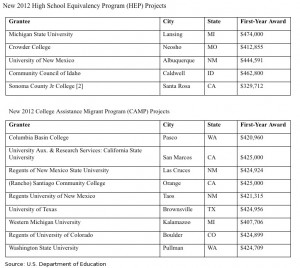U.S. Department of Education awards $5.9 million for migrant student aid
Posted by Elena del Valle on July 18, 2012
Click to enlarge
Photo, chart: U.S. Secretary of Education
Targeting migrant students and their families? You may be interested to know that the U.S. Department of Education awarded $5.9 million to 14 grantees in nine states for education for high school and college students migrant or seasonal farm workers, or the children of such workers. The five-year grants are awarded under the High School Equivalency Program (HEP) and the College Assistance Migrant Program (CAMP) through the Department’s Office of Migrant Education said to serve 5,000 HEP and 2,000 CAMP students annually.

Arne Duncan, U.S. Secretary of Education
“The students helped by HEP and CAMP are some of the most motivated learners in America,” said Arne Duncan, United States Secretary of Education. “These grants will help hardworking farmworkers and their families obtain the quality education that they need to compete in the 21st century global economy.”
The purpose of the HEP grants is to help migrant and seasonal farmworkers, and members of their immediate families obtain general education diplomas that meet the guidelines for high school equivalency established by the state in which the HEP project is conducted. The program helps migrant youth gain employment or placement in an institution of higher education or other postsecondary education or training via counseling, job placement, health care and housing for residential students.
CAMP grants support students who are migratory or seasonal farm workers, or the children of such workers, during their first year of undergraduate studies and to continue in postsecondary education. The mission of the Office of Migrant Education (OME) is to “provide excellent leadership, technical assistance, and financial support to improve the educational opportunities and academic success of migrant children, youth, agricultural workers, fishers, and their families.”










